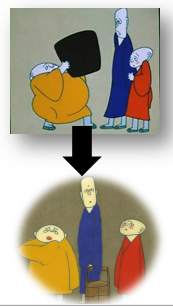About

This is a Chinese
animated movie, based on the ancient Chinese proverb "One monk will shoulder two
buckets of water, two monks will share the load, but add a third and no one will
want to fetch water".
Percept
The movie
basically depicts the innate nature of human beings, how they respond to
various situations, and moreover to the same situation in different contexts.
Initially,
we have only one monk who treads his way to the monastery and does whatever was
called on for his survival. Not only survival, he was also putting efforts to accomplish
the underlying ritualistic intents.
Then comes
the second monk, facing similar mundane conditions as the previous one. Both of
them begin with an unstated agreement of coexistence. There are efforts to
survive, more to coexist but not collaborate. As a result, they reach a sort of
edge of sustenance in a few days, not living but sort of elapsing their span in
the monastery.
And there
enters the third monk, facing similar situations again with certain novelties
in responses and individualistic constraints. But this time, as the two monks
have already reached ‘that edge’,
surviving together becomes a pain. We find a sense of buck-passing amidst the
three. The productivity, effort-effectiveness and even the expected cordiality
of their relations is all swayed off. Moreover their ritualistic commitment
towards Buddha also goes for a toss when they start disregarding their
self-stitched norms out of laze and reluctance.

Also, there’s this interesting character of a mouse in the monastery. It has played a significant role in the story. With the first monk alone, it is just a disturbance in his course of action. But with more monks joining in, it exemplifies the sense of irresponsibility and reluctance amidst. This mouse is the creator of various testing circumstances and also the one which brought about a change in the monks’ perspective of coexistence. This event when the monastery catches fire is a turning moment in the movie. In such situation of plight also the monks try to retain their individualistic motives, the difference being that all three motives were quite aligned to each other. All three monks wanted to save their lives and, in a very dogmatic gesture, the monastery as well. And when they observe that they don’t stand a chance to do it single-handedly is when they join hands and really ‘collaborate’. Such collaboration attains a new stature when they re-establish the monastery and re-invent ways to coordinate in a better way oriented towards synergy.
Pick of the story
In a group,
it is inevitable not to face individualistic ambitions, and more often than
not, their clashes as well. In such instances, it becomes really important to
tailor it to achieve a win-win situation.
As we see,
for the monks, they were equally competent and efficient by themselves, but
since there weren’t any incentives involved, none of them wanted to work in
others’ presence. Such a group, can not only be deteriorating for the business
it is responsible for, but also discouraging for others. And as we saw, to the
verge of diminishing all the fame once earned.
However its
only a matter of realisation, when people understand that there’s only a limit
to what a person can accomplish single-handedly. And howsoever the components
be, they can always be conglomerated to a winning team.
This calls
for a sense of coherence, streamlining one’s aspirations with those of the team
and seeking the role of a contributor. That is when we can leverage the
benefits of bringing together diverse talents.
PS: Yet to come… Revisiting the
story with the way it can impact the ‘motivation dynamics’ involved.
Till then, Three Monks @Youtube
Happy Learning... :)
Till then, Three Monks @Youtube
Happy Learning... :)

No comments:
Post a Comment